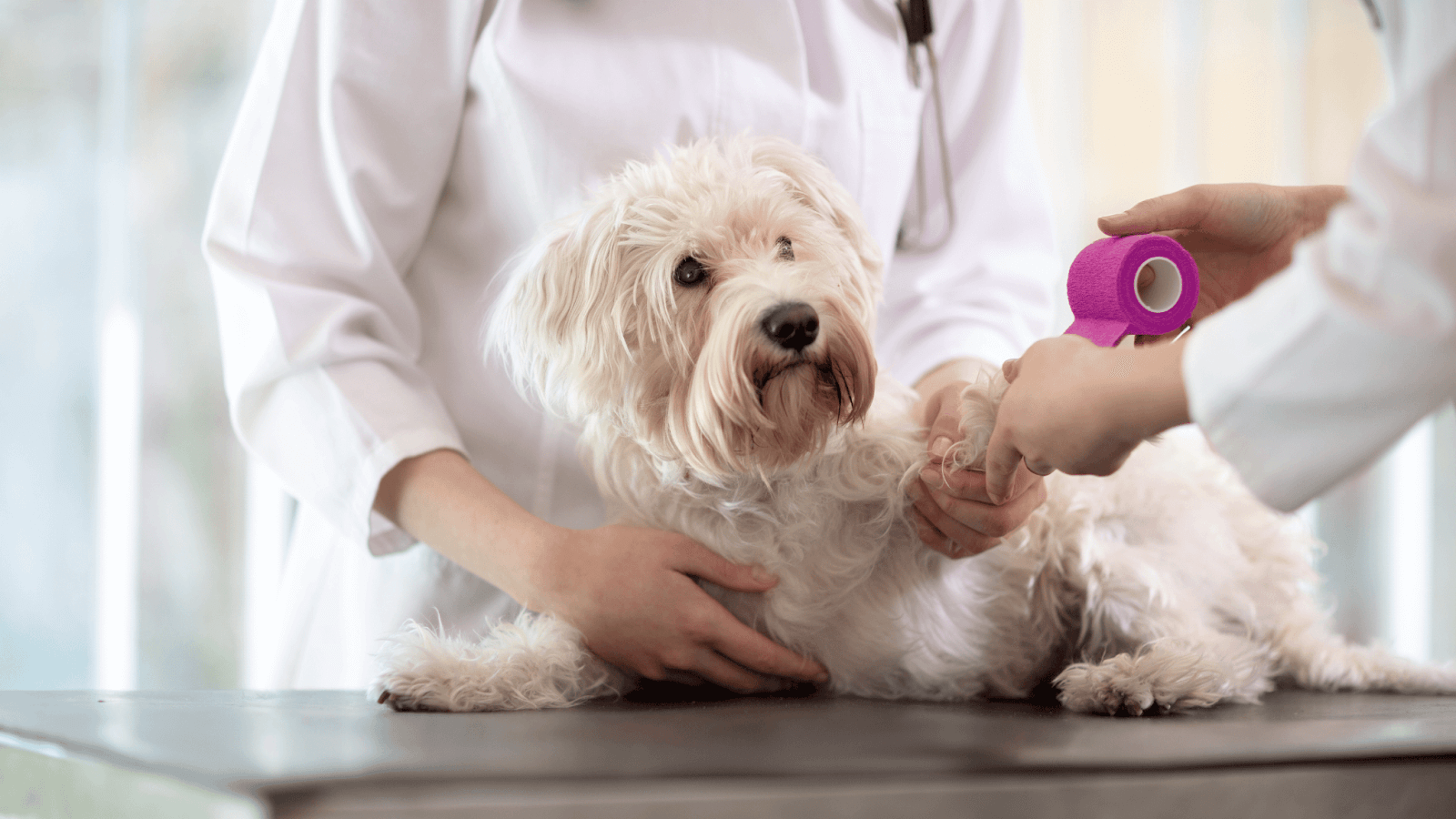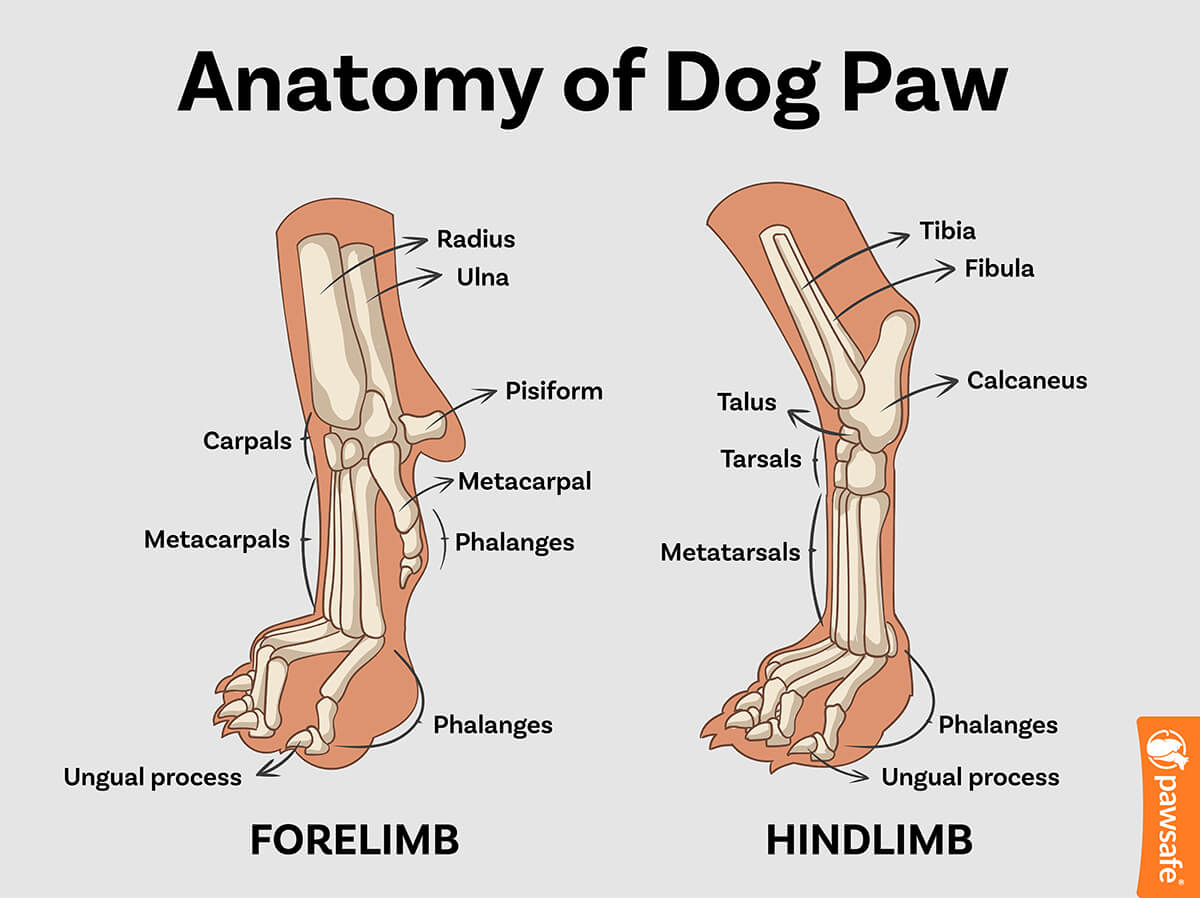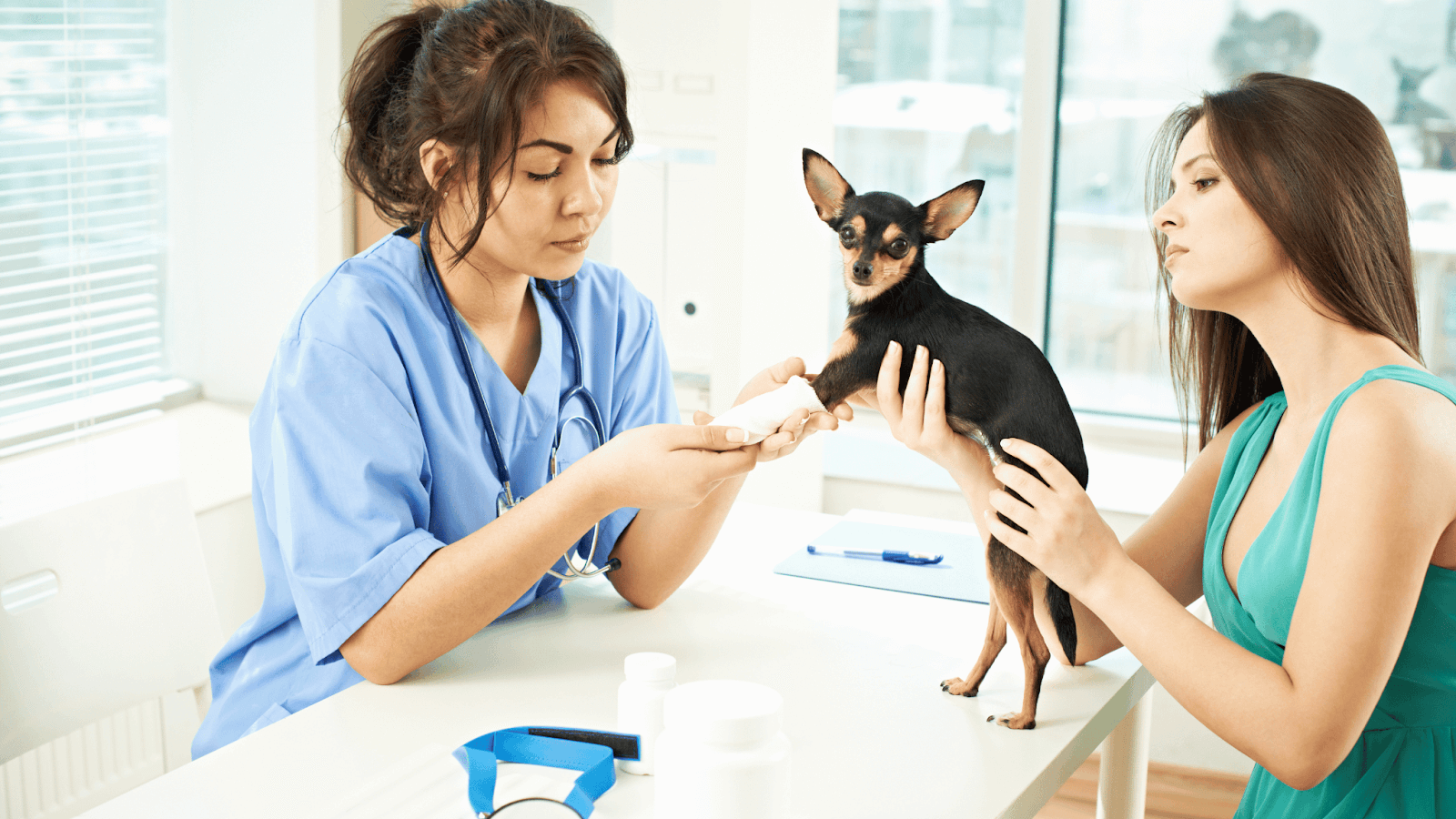Broken paws can be a painful and distressing injury for dogs. It’s important for dog owners to know the signs of a broken paw in their canine companion so they can seek veterinary care as soon as possible. A broken paw can occur in any of the four limbs and can range from a hairline fracture to a complete break.
Remember that paw care is an essential part of dog ownership. Clip nails monthly with doggy nail trimmers and always protective apply a paw balm to the pads. This is because nail infections from overgrown or broken nails or skin infections in the toes can weaken the bone density and indirectly lead to broken toes in dogs. If you suspect your dog has a broken paw, seek veterinary care immediately to ensure proper treatment and a speedy recovery. So, let look at Bone Trauma in Dogs so that you know how to identify it and what to do, even if you can’t afford it.
So, What Are The Signs Of A Broken Paw In A Dog?
One common sign of a broken paw in a dog is limping or favoring one leg. The dog may also be reluctant to put weight on the affected paw. Swelling, bruising, and tenderness around the paw or leg are also typical symptoms of a broken paw. In severe cases, the bone may even be visible through the skin. It’s important to note that some dogs may not show any visible signs of a broken paw, so it’s crucial to pay attention to changes in behavior or mobility.
Here are some common signs of a broken paw in a dog:
- Limping or avoiding putting weight on the affected paw;
- Swelling or bruising around the paw or leg;
- Pain or sensitivity when the paw is touched or manipulated;
- Visible deformity or misalignment of the paw or leg; and
- Whimpering, crying, or other signs of discomfort or distress.
If a dog is exhibiting any of these signs, it is important to seek veterinary care as soon as possible. Delaying treatment can lead to further complications and prolong the dog’s pain and discomfort.
In some cases, a broken paw may also be accompanied by other symptoms such as fever, loss of appetite, or lethargy. These symptoms may indicate a more serious injury or infection and should be evaluated by a veterinarian.
Overall, being able to identify the signs of a broken paw in a dog can help pet owners provide prompt and appropriate care for their furry friends.
Related Posts:
- Why is My Dog Stumbling While Walking: A Complete Guide To Causes and Solutions
- Do Dogs’ Tails Have Bones? Exploring the Anatomy of Man’s Best Friend
- Dog back leg shaking
How Do You Tell if Your Dog’s Foot is Broken or Sprained?
When a dog is limping or favoring one foot, it can be difficult to determine if they have a broken or sprained paw. Here are some signs to look for:
Swelling
If the paw is swollen, it could be a sign of a fracture or sprain. Swelling can occur immediately after an injury or develop gradually over time.
Pain
If your dog is in pain, they may be hesitant to put weight on the affected paw. They may also whimper or cry when the paw is touched or manipulated.
Deformity
If the paw looks misshapen or is pointing in an abnormal direction, it could be a sign of a fracture.
Discoloration
If the paw is bruised or discolored, it could be a sign of a sprain or fracture.
Limping
If your dog is limping or favoring one paw, it could be a sign of a sprain or fracture. They may also hold the paw off the ground completely.
If you suspect that your dog has a broken or sprained paw, it is important to seek veterinary care as soon as possible. Delaying treatment can lead to further complications and prolong your dog’s recovery time.
Recognizing Physical Signs
Dogs are active creatures and are prone to injuries. One of the most common injuries that dogs can suffer from is a broken paw. Recognizing the physical signs of a broken paw is essential for pet owners to seek immediate veterinary care for their furry friend.
Limping or Difficulty in Movement
One of the most common physical signs of a broken paw in dogs is limping or difficulty in movement. Dogs may show a noticeable limp or may avoid putting weight on the affected paw. They may also show reluctance to walk, run, or play, and may even drag the affected paw while walking.
Swelling or Abnormal Shape
Swelling or an abnormal shape in the paw is another physical sign of a broken paw in dogs. Pet owners should regularly check their dog’s paws for any swelling or deformities. A broken paw may appear swollen, bruised, or inflamed. The paw may also look misshapen or bent out of place.
Paw Sensitivity or Pain
Dogs with a broken paw may also show signs of paw sensitivity or pain. They may yelp or cry out in pain when the affected paw is touched or manipulated. Dogs may also lick or chew at the paw excessively, indicating discomfort or pain.
In conclusion, recognizing the physical signs of a broken paw in dogs is critical for pet owners to seek immediate veterinary care for their furry friend. If you notice any of the signs mentioned above, it is essential to take your dog to a veterinarian as soon as possible.
Understanding Behavioral Changes
Dogs use their paws for various activities such as walking, running, playing, and scratching. A broken paw can cause a lot of discomfort and pain to the dog. In some cases, the dog may not even be able to walk or stand on the affected paw. Understanding the behavioral changes of the dog can help identify a broken paw.
Excessive Licking or Chewing
Dogs tend to lick or chew on their paws when they are experiencing discomfort or pain. If your dog is excessively licking or chewing on a specific paw, it may indicate a broken paw. The dog may also bite or scratch at the paw, leading to further injury. You may notice redness, swelling, or bleeding on the paw.
Changes in Appetite or Sleep Patterns
A broken paw can cause a lot of pain, making it difficult for the dog to eat or sleep comfortably. If your dog is experiencing a broken paw, you may notice a change in their appetite or sleep patterns. They may refuse to eat or drink, or they may sleep more than usual. The dog may also show signs of restlessness or discomfort during sleep.
Agitation or Aggression
A dog that is experiencing pain or discomfort may become agitated or aggressive. They may snap or growl when touched or approached, particularly on the affected paw. The dog may also become more irritable or easily agitated.
It is important to monitor your dog’s behavior and seek veterinary care if you suspect a broken paw. A veterinarian can perform a physical examination and recommend appropriate treatment.
Dog Paw Anatomy: Which Bones Can Break in the Paw?
The paw of a dog consists of five toes on the front paw and four on the back (usually), each with three bones called phalanges. The bones in the paw are connected to the bones in the leg by a joint called the wrist. The wrist is made up of two bones, the radius, and the ulna. The bones in the paw are also connected to each other by ligaments, which provide stability and support.
The most common bones to break in a dog’s paw are the phalanges. The phalanges are small and delicate bones that can easily break if the dog jumps from a high place or lands awkwardly. The phalanges in the paw can also break if the dog’s paw is stepped on or caught in a door.
In addition to the phalanges, the wrist bones can also break in a dog’s paw. The radius and ulna are larger and more robust bones than the phalanges, but they can still break if the dog experiences trauma to the paw.
It is essential to seek veterinary care if a dog is limping or showing signs of pain in their paw. A veterinarian can perform an X-ray to determine which bones are broken and develop a treatment plan to help the dog heal.
Overall, understanding the anatomy of a dog’s paw can help pet owners identify which bones can break in the paw and seek appropriate medical attention if necessary.
Seeking Veterinary Care
Initial Examination
If a dog is suspected of having a broken paw, it is essential to seek veterinary care immediately. The veterinarian will examine the dog’s paw and determine the severity of the injury. During the initial examination, the veterinarian will look for signs of swelling, bruising, and pain. They may also check the dog’s vital signs and ask the owner about the dog’s medical history.
Diagnostic Tests
Once the veterinarian has completed the initial examination, they may recommend diagnostic tests to confirm the diagnosis. These tests may include X-rays, CT scans, or MRI scans. These tests will help the veterinarian determine the extent of the injury and develop a treatment plan.
Treatment Options
Treatment options for a broken paw will depend on the severity of the injury. In some cases, the veterinarian may recommend conservative treatment, such as rest, ice, and pain medication. In more severe cases, the veterinarian may recommend surgery to realign the bones and stabilize the paw. The veterinarian may also recommend physical therapy to help the dog regain strength and mobility.
It is important to follow the veterinarian’s instructions for care and follow-up appointments to ensure the dog makes a full recovery. If left untreated, a broken paw can lead to long-term complications and can be extremely painful for the dog.
What is the Treatment for a Dog with a Broken Paw?
The treatment for a broken paw in a dog depends on the severity of the injury. In minor cases, rest and immobilization of the affected paw may be enough for the bone to heal. However, in more severe cases, surgery may be necessary to realign the bones and stabilize them with pins, plates or screws.
After surgery, the dog may need to wear a cast or a splint for several weeks to allow the bone to heal properly. Pain medication and antibiotics may also be prescribed to manage pain and prevent infection.
It is important to follow the veterinarian’s instructions carefully to ensure proper healing and prevent complications.
Related Posts:
Can a Dog’s Broken Paw Heal on its Own?
If a dog has a broken paw, it is important to seek veterinary care as soon as possible. While some minor fractures may heal on their own with rest and immobilization, more severe fractures will require medical intervention to ensure proper healing and to prevent long-term complications.
The ability of a dog’s broken paw to heal on its own largely depends on the severity of the fracture. In general, if the fracture is a simple, clean break and the bones are in good alignment, there is a chance that the paw may heal on its own with proper rest and immobilization. However, if the fracture is more complex or the bones are significantly displaced, it is unlikely that the paw will heal without medical intervention.
It is important to note that even if a dog’s broken paw appears to be healing on its own, it is still important to seek veterinary care to ensure that the healing process is progressing properly and to address any potential complications. Additionally, untreated fractures can lead to long-term complications such as arthritis, so it is important to seek medical attention as soon as possible.
Overall, while some minor fractures may heal on their own with rest and immobilization, it is important to seek veterinary care for any suspected broken paw to ensure proper healing and to prevent long-term complications.
Preventing Paw Injuries
Regular Paw Checks
Proper Exercise
Use of Protective Gear
In conclusion, preventing paw injuries is essential for the health and wellbeing of dogs. Regular paw checks, proper exercise, and the use of protective gear can help reduce the risk of paw injuries. Pet owners should consult with their veterinarian if they notice any signs of paw injuries or have any concerns about their dog’s paw health.
Is There a Dog Broken Leg Home Treatment?
If a dog has a broken leg, it is important to seek professional veterinary care immediately. However, there are a few things that can be done at home to help stabilize the injury and provide some relief to the dog.
The first step is to keep the dog calm and still. Movement can cause further damage to the injured limb, so it is important to keep the dog confined to a small area where it cannot move around too much.
Next, the dog’s leg should be immobilized using a splint or a cast. This can help to prevent further damage and allow the bone to heal properly. A homemade splint can be made by wrapping a sturdy material, such as a magazine or a stick, tightly around the leg and securing it with tape or a bandage.
It is important to monitor the dog’s condition closely and look out for signs of infection or worsening pain. If the dog’s condition does not improve or if it seems to be getting worse, it is important to seek veterinary care immediately.
In summary, while there are some things that can be done at home to help stabilize a broken leg in a dog, it is important to seek professional veterinary care as soon as possible.
What Do I Do if I Have No Money and My Dog’s Leg or Paw is Broken?
If a dog’s leg or paw is broken, it is crucial to seek veterinary attention immediately. However, not everyone has the financial means to pay for the necessary treatment. In such a situation, there are a few options available.
One option is to reach out to local animal welfare organizations or charities that may be able to assist with the cost of treatment. Many of these organizations have funds set aside to help pet owners in need. It is worth contacting them to see if they can offer any assistance.
Another option is to consider applying for veterinary financing. Many veterinary clinics offer financing options that allow pet owners to pay for treatment over time. This may be a viable option for those who cannot afford to pay for treatment upfront.
If these options are not feasible, it may be necessary to consider surrendering the dog to a local animal shelter or rescue organization. While this is not an ideal solution, it is better than allowing the dog to suffer without treatment.
It is important to remember that delaying treatment for a broken paw or leg can lead to serious complications and even permanent damage. Therefore, it is essential to seek veterinary attention as soon as possible, even if it means reaching out to local organizations or considering surrendering the dog.
What are the Most Common Causes of a Broken Paw in Dogs?
Studies show a broken paw is a common injury among dogs, and it can be caused by a variety of factors. Some of the most common causes of a broken paw in dogs include trauma, falls, and accidents. Dogs that are involved in high-impact activities such as hunting, agility, or sports are more prone to paw injuries.
In addition, certain breeds of dogs are more susceptible to paw injuries due to their body structure. For example, breeds with long and thin legs such as Greyhounds and Whippets are at a higher risk of paw injuries.
Another factor that can contribute to paw injuries is obesity. Overweight dogs put more pressure on their paws, which can lead to fractures and other injuries.
It is important for dog owners to be aware of the signs of a broken paw and take immediate action if they suspect their dog has sustained an injury. Prompt treatment can help prevent further complications and ensure a faster recovery.
Frequently Asked Questions (FAQs)
How can I tell if my dog has a broken paw?
What are the symptoms of a broken paw in a dog?
What should I do if my dog has a broken paw?
How much does it cost to treat a dog’s broken paw?
Final Thoughts
If you suspect that your dog has a broken paw, it is important to seek veterinary attention immediately. Delaying treatment can result in further injury and complications.
Remember to always be observant of your dog’s behavior and movements. If you notice any of the signs mentioned in this article, take the necessary steps to ensure your dog’s health and safety.
It is also important to keep your dog’s environment safe and free from hazards that could cause injury. Regular exercise, a healthy diet, and proper grooming can also help prevent injuries.
By being proactive and attentive to your dog’s needs, you can help ensure that they live a long and healthy life free from injury and pain.











